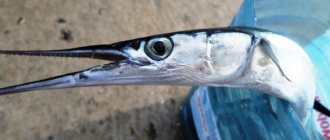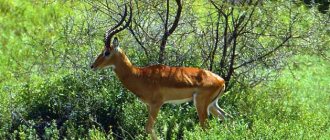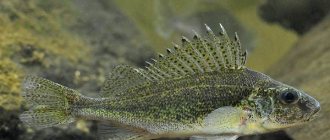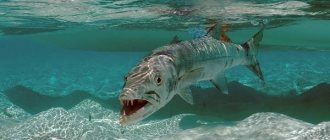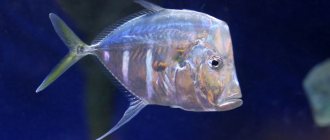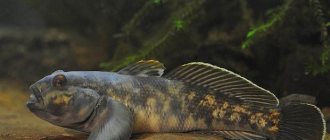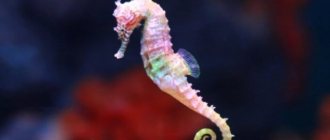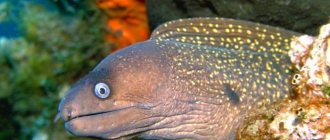Kaluga sturgeon (or Amur kaluga) is one of the rarest and largest species of freshwater fish. Its terrifying appearance and huge dimensions make it a real threat to fishermen. Currently, this species of the Ray-finned class is listed in the International Red Book and the Red Book of Russia. This happened due to constant poaching attacks on fresh water bodies and the massive catch of individuals of this species.
Kaluga has a trapezoidal head
Description of Kaluga
In appearance, kaluga is similar to beluga, differing from it in the smaller number of rays in the dorsal fin (less than 60), a significantly larger mouth and the largest first bug in the dorsal row. The anal fin has 26-35 rays. There are 10-16 dorsal bugs, 32-45 lateral bugs, 8-12 abdominal bugs. There are 16-22 gill rakers. The body between the bugs is covered with small grains, among which sometimes larger rounded plates are found in larger specimens. Of the dorsal bugs, the first one is the largest. The mouth is huge, semi-lunar in shape, partly extending onto the sides of the head. Antennae without leaf-like appendage.
Distribution of kaluga
Endemic to the Amur basin: from the estuary to the upper reaches. Found in Ussuri, Sungari, Zeya, Shilka, Arguni, Onon, Ingoda, lakes Khanka, Bolon, Orel. It does not go out to sea beyond the estuary. It exists in the Amur Estuary, but is not found in the Sea of Okhotsk and generally does not go beyond the desalinated water of the Amur in the sea. Kaluga also lives in some lakes, for example, in Lake Orel, which is 50 km above Nikolaevsk. Kaluga is known off the northwestern coast of Sakhalin, where it is found from the northern part of the island to Tyk Bay and to the city of Alexandrovsk, sometimes entering river mouths (the Viakha River). In the Amur it forms semi-anadromous (estuary) and residential forms.
Human use[edit | edit code]
Formerly a valuable commercial fish. The maximum catch was about 600 tons at the end of the 19th century, the average annual catch in 1953-1957. - 200 tons. Kaluga in China is fished using large mesh nets (akhans). The previously used hook and line tackle was banned in the 50s. Occasionally, large kaluga are caught as bycatch when fishing for partial and anadromous salmon fish in the Amur using floating nets. All harvested kaluga was consumed in the fishing areas. Meat is consumed mainly fresh[5]. Meat and caviar of kaluga grown in pond farms (according to official data) are offered for sale in China, including for export[13].
Number and limiting factors[edit | edit code]
There is no exact data on the number in recent years; the Red Book of Russia suggests the existence in nature of about 2,000 individuals older than 2 years. According to the Russian and international Red Book, the Kaluga population continues to decline due to pollution of the Amur, unlimited commercial fishing by Chinese fishermen and poaching in Russia (by Russian and Chinese fishermen). Fishing in Russian waters has been prohibited since 1958[8][14], in Chinese waters commercial fishing for kaluga and other sturgeon is legalized (licensed by the state)[15].
In the lower reaches of rivers in western Kamchatka it occurs sporadically, but apparently regularly. Its abundance here is probably determined by the general state of the estuary population in the Amur basin.
Security[edit | edit code]
- The species is listed in the Red Book of Russia.
- The species is listed in the International Red Book.
Since 1958, there has been a ban on kaluga fishing in Russian waters; regulated fishing was resumed in 1991, and since 2000 it has been completely prohibited again, with the exception of control fishing by the Khabarovsk branch of the Pacific Research Fisheries Center [16]. The Russian catch of kaluga in 1995 was 100 tons, in 1996 - 81 tons[5]. On a small scale, juveniles are released by fish hatcheries in Russia and China[8][14][17][18][19].
Despite a long ban on the catch and release of juveniles in the Soviet (now Russian) part of the Amur basin, due to poaching and pollution of the Amur, kaluga stocks have not been restored; since 2004, a decline in its numbers has been noted[20]. Scientific research fishing is carried out in the Amur and the estuary, the volume of catch in 2006 was 13.5 tons, the volume of illegal fishing in Russia and commercial fishing in the Chinese part of the Amur, according to expert estimates, reaches several hundred tons[21]. Currently, the main way to maintain the kaluga population is its artificial reproduction and release of juveniles[9].
Young kaluga feed in the Amur Estuary and the Tatar Strait[9]. Despite the bans, the local population of the northern coast of Sakhalin and the mainland of the Tatar Strait illegally catches Red Book fish with fixed nets. The average size of kaluga mined is up to 30 kilograms[22].
Scientific and practical significance of species conservation[edit | edit code]
It is of scientific and practical interest as an endemic of the Amur basin[8], and is considered a particularly valuable biological resource[19]. Also interesting is the phenomenon of extended sea migration in a species that generally leads a freshwater lifestyle, but is capable of successfully adapting to living in an unusual marine environment.
Nutrition
Adult kaluga feed mainly on fish; large - chum salmon, pink salmon, carp, grass carp, silver carp. In the Amur estuary, in addition to migratory salmon and lamprey, it feeds on shrimp, herring, smelt, whitefish and juvenile navaga and flounder, and also eats its own juveniles before the start of the pink salmon run. In winter, food does not stop. Small - minnows, lamprey, ide, etc.; fry - mosquito larvae, freshwater shrimp, mysids, etc. Small salmon eat minnows, juvenile horses, chebak and even killer whales.
Kaluga lifestyle
There are 2 forms: semi-anadromous estuary, entering the Amur to spawn, and residential river. The interval between spawning for the same individual is at least 3-4 years. The migratory estuary kaluga enters the river with reproductive products of varying degrees of maturity: some with well-developed reproductive products - these spawn in the lower reaches; others with rudimentary sexual products - these rise high up the river for spawning, to Blagoveshchensk and higher. Thus, the migratory estuary kaluga has the same two forms—spring and winter—as the beluga. Residential Amur Kaluga does not make large movements along the Amur and lives within the river in relatively isolated groups. Juveniles enter lakes to feed. During the winter, Kaluga concentrates in the Amur riverbed. Does not lie on holes.
Reasons for rejection [edit]
There are several reasons why this particular species is declining. To begin with, they are seriously overfished. They have been under threat from poaching since the 1900s. After World War II, in 1948, 61 tons of kaluga were caught, an incredible amount for a species of its size (Krikhtin et al. 1997). They are extremely vulnerable to extinction due to poaching due to their late sexual maturity. On average, their sexual maturity lasts from 6 to 25 years. Production of sturgeon caviar, including Kaluga caviar, averaged 117 tons per year from 1957 to 2005. The animals are hunted for their unfertilized eggs because sturgeon caviar is considered a delicacy for people around the world (Yang et al. 2006). This market is reducing the Kaluga population and only accelerating the process of their extinction. Another cause of danger is river pollution, especially near spawning grounds. This resulted in deformed eggs and birth defects.[5] [6] [7]
Reproduction
The weight of eggs before spawning is 15-25% of the total body weight. Spawning in the Khabarovsk region in June - July (at a water temperature of 12-14 ° C), in deep places with fast currents, on pebble and rocky soil. Sometimes spawning lasts until July. Spawning grounds are scattered throughout the Amur, starting a few kilometers from the mouth of the Amur; then there is Sredne-Tambovsky, below the village. Troitsky, at the exit of the Gion channel, 65-75 km below Khabarovsk, 100 km above Khabarovsk, etc. The caviar is large, 3.6-4 mm in diameter, sticky. Adult kaluga do not spawn every year, but at least every other year, and with age, the intervals between spawning increase to three, four or more years. The fertility of kaluga is almost the same as that of beluga. According to V.K. Soldatov, a kaluga weighing 540 kg and 4.18 m long has 4,100,000 eggs, a kaluga weighing 208 kg has 1,978,000, and a kaluga weighing 150 kg and 2.45 m long has 665,000. The number of males and females is almost the same.
Behavior[edit]
Eating behavior
Kaluga sturgeon hatch on shallow gravel beds in the freshwater estuaries of the Amur River. Their parents do not play any role in their lives. They remain in the egg for 83 to 295 hours and hatch from the yolk sac, which feeds them for up to 8 or 9 days. After this, the Kaluga sturgeon is forced to hunt. They prey on tiny zooplankton, insects and shrimp. They reach the sea using the current and stay there until they are ready to breed, between 10 and 14 years of age. Females can only breed every four years. Their spawning season begins in May and ends in July. Adult Kaluga sturgeon travel in small groups of 3 to 20 individuals to shallow gravel beds to spawn. Sometimes, if the Kaluga sturgeon is too large, it can die by getting stuck in shallow water. The Kaluga sturgeon can interbreed with the Amur sturgeon.
Adult Kaluga sturgeon have a huge appetite. They eat pike, carp, herring, chum salmon, chum salmon and most other fish and shellfish that can fit in their mouth. Kaluga sturgeon can live up to 55 years.
Development of Kaluga
The period of embryonic development at a water temperature of 18.3°C lasts about 108 hours, and at a temperature of 9-10°C - 15-16 days. The length of hatched embryos is 11.8 mm. The larvae switch to mixed feeding 8 days after hatching at a water temperature of 20.5°C and after 16 days at a temperature of 15°C with a length of about 20 mm. Hatched embryos and larvae with the yolk sac not yet absorbed are carried downstream of the Amur. By the end of autumn, the fry have a length of 20-30 cm and a weight of 17-97 g. The average length of yearlings is 35 cm, their average weight is 146 g. The growth of kalugas from the Liman significantly exceeds the growth of kalugas from the Amur itself. Kaluga from the Amur Liman is characterized by faster growth than kaluga from the Amur.
The largest fish in Russia: total length
It is a pity that there are no big fish in Russia at present.
Once upon a time, Russia could boast of large specimens of beluga and kaluga. Poachers have almost completely destroyed valuable fish. Once upon a time, the rivers of Russia were teeming with fish. Beluga caviar was exported abroad and sold for gold. The fish lived in the Caspian and Black Seas, but were caught in the Volga and Dnieper, where they went to spawn. In the 1920s, the fishery industry was founded on beluga fishing.
The largest fish in Russia after the revolution was caught in Kaluga in 1922. It was more than 4 m long and weighed 1222 kg.
4.4 m in length and weighing a ton, a fish was caught during spawning in May, with 190 pounds of caviar in its belly. Her age was determined to be 75 years.
They say that in the middle of the 17th century, a fish weighing 2 tons and about 9 m long was extracted from the Volga, but scientists consider this record to be fake. According to all calculations, a fish whose length is more than 6 m would not be able to exist. The ridge simply could not withstand such a load.
Beluga is a long-lived fish. She can live more than 100 years. Females enter maturity only from 13-17 years of age.
Already by the 50s of the 20th century, the beluga began to shrink - it was not allowed to grow to normal size. The largest fish in Russia, living in the Volga-Caspian region, has no longer gained more than 150 kg. Its length ranged from 1.5 to 2.5 m.
Another large fish lives in Russia - kaluga. She spends her entire life in the waters of the Sea of Okhotsk, and rises to the Amur delta to spawn. At the beginning of the last century, specimens that weighed more than a ton were still encountered. In the 17th century, a kaluga weighing 1,140 kg and up to 5.6 m long was even caught. Modern poachers have practically destroyed this type of fish.
Some people confused beluga and kaluga. But distinguishing them is quite simple: the belly of the kaluga is painted red. Beluga caviar is more valuable.
Currently, beluga sturgeon are artificially bred in Russia. The farm is located in Astrakhan, on the banks of the Volga. “Domestication” began with Russian sturgeon and Caspian beluga. These fish species are not currently found in the wild.
Of course, neither beluga nor sturgeon grow to the size of the fish that were occasionally caught in the Volga delta. 1.5 meters and about 20-25 years of life - this is considered sufficient time to extract an expensive product from fish - beluga or sturgeon caviar. In Tsarist Russia, it was considered unworthy for nobles to eat fish caviar unless the female’s color was pure white and she had not lived 50 years.
Fry from farms are constantly released into the wild - this spectacle usually attracts many tourists. But over the past 20 years, no one has been able to spot a sturgeon longer than an adult’s elbow in free swimming.
If a beluga is accidentally caught, it must be released. Even if it is accidentally grabbed by hand - this happens during spawning - this is already considered poaching.
The largest fish in Russia in recent years was caught in 1993. This record was recorded by the official organization “Soviet Expeditions”. A huge taimen, whose weight is 41 kg and the length from the head to the scaly part of the tail is measured to be 1.2 m, was caught on the Keta River in Siberia. It has still not been possible to break this fishing record for the largest fish.
For modern fishermen, the big fish in Russia are pike up to 30 kg and catfish about 20 kg. Will it really not be possible to restore the population of the beluga, which was famous not only as the largest fish in Russia, but as the largest fish in the world?
Economic importance
Kaluga is the most valuable commercial fish. At the end of the 19th century. in the lower reaches of the Amur, its catch reached 580 tons. Kaluga stocks were undermined at the turn of the 19th and 20th centuries. It is prepared mainly fresh.
The species is included in the IUCN Red List.
Literature: 1. Lebedev V.D., Spanovskaya V.D., Savvaitova K.A., Sokolov L.I., Tsepkin E.A. Pisces of the USSR. Moscow, Mysl, 1969 2. L. S. Berg. Freshwater fish of the USSR and neighboring countries. Part 1. Edition 4. Moscow, 1948 3. Atlas of freshwater fish of Russia: In 2 volumes. T.1. / Ed. Yu.S. Reshetnikova. -M.: Nauka, 2003. - 379 pp.: ill. 4. Commercial fish of Russia. In two volumes / ed. O.F.Gritsenko, A.N.Kotlyar and B.N.Kotenev. - M.: VNIRO publishing house. 2006.- 1280 p. (Vol. 1 - 656 pp.).
Habitat[edit]
- Appendix II
includes species that, although not currently endangered, may become so without trade controls. Regulated trade is permitted provided that the exporting country issues the permit based on findings that the specimens were legally acquired and the trade will not harm the survival of the species or its role in the ecosystem. - Legislation of the Soviet Union
Historically, most environmental measures were aimed at controlling local and national fisheries. Commercial sturgeon fishing was banned in the Soviet Union in the periods 1923-1930, 1958-1976 and from 1984 to the present (Vaisman, Fomenko, 2007). The Kaluga sturgeon was included in Appendix II of the Convention on International Trade in Endangered Species of Wild Fauna and Flora (CITES) in 1998.

